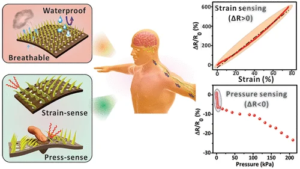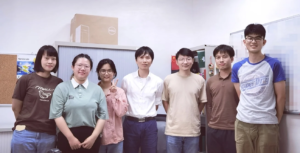A research team led by Zhou Bingpu, assistant professor in the Institute of Applied Physics and Materials Engineering (IAPME), University of Macau (UM), has designed a breathable and waterproof electronic skin (e-skin). The highly sensitive e-skin can recognise and distinguish between pressure and strain from the environment and is expected to be applied in fields such as real-time health monitoring, human-machine interaction, environmental perception, and intelligent control. The research result has been published in ACS Nano, a leading international journal in the field.
The skin, as the largest organ of the human body, plays an important role in the real-time interaction between people and their surroundings. With the emergence of flexible electronics, soft robotics, and prosthetics, the field of flexible e-skin that can mimic the sensory functions of human skin has been growing rapidly in recent years and has attracted a lot of attention. In addition to having perfect tactile perception, e-skin should also be breathable and waterproof, allowing it to be worn for long periods of time and used in different scenarios.
With this in mind, the research team has designed a flexible e-skin with a porous and three-dimensional surface microstructure. Via the synergy of magnetic force, surface tension, gravity and nano-aggregation, the three-dimensional structure and porous surface of the e-skin are formed automatically when an external magnetic field is applied. With multiple parameters being coordinated by the team, the e-skin is able to recognise and distinguish pressure and strain from the environment and the human body. The porous structure also allows for sweat evaporation to enable a comfortable wearing experience. In addition, the waterproof function can avoid liquid interference, which is one of the common issues of e-skin systems. The study comprehensively shows the sensing capabilities of the e-skin, including the recognition of facial expression, dynamic monitoring of foot pressure, and detection of joint bending. Furthermore, thanks to the ability to output non-overlapping electrical signals in response to different tactile inputs (pressure and strain), the e-skin also demonstrates the advantages of being used in different human-machine interfaces, such as Morse code communication, robot control, and multi-command systems.
The corresponding authors of the paper are Prof Zhou, and Prof Xu Qingsong in the Faculty of Science and Technology. The first author of the paper is PhD student Lei Ming in the IAPME. This study was funded by the Science and Technology Development Fund, Macao SAR (File no: 0088/2021/A2 and 0026/2020/AGJ). The full version of the paper can be viewed at https://doi.org/10.1021/acsnano.2c04188
澳門大學應用物理及材料工程研究院助理教授周冰樸的研究團隊設計出一種兼具透氣性及防水功能的多孔電子皮膚。該電子皮膚可靈敏感知及識別外界的“壓力”或“拉力”,有望應用於穿戴式實時健康監測、人機交互、環境感知、智能控制等不同領域。該研究成果已獲國際知名學術期刊《美國化學會 – 納米》(ACS Nano)發表。
皮膚是人體最大的器官,在人類與周圍環境的實時交互中扮演著重要的角色。近年來,隨著柔性電子、軟體機器人、人體修復術等學科的發展,可模擬人體皮膚感知功能的柔性電子皮膚正迅速發展,並引起了廣泛的關注。然而,除了完善仿皮膚功能的機械感知功能之外,電子皮膚還應具備一定的透氣性及防水性,以推進其在長時間佩戴及不同場景中的可靠和廣泛應用。
有鑒於此,研究團隊設計出多孔且具三維表面微結構的柔性電子皮膚。利用磁力、表面張力、重力及納米結構團聚的協同作用,該電子皮膚的三維結構和多孔表面可在外加磁場的作用下自發形成。團隊通過多參數的協同調控,使該電子皮膚能靈敏感知並識別外界及人體的“壓力”和“拉力”,且孔隙結構的存在利於汗液揮發而提升舒適性,亦避免了液體串擾信號等柔性電子皮膚普遍存在的問題。相關論文綜合展示了該電子皮膚的全方位檢測功能,包括面部表情識別、足底壓力動態感知、關節彎曲監控等。同時,得益於能因應不同的機械輸入(壓力、拉力)而輸出非重叠信號,該電子皮膚亦顯示了在不同的人機交互界面如摩斯密碼傳輸、機器人控制、多指令系統等方面的應用優勢。
該項研究的通訊作者為周冰樸和科技學院教授徐青松,論文的第一作者為澳門大學應用物理及材料工程研究院博士生雷銘。此項研究由澳門特別行政區科學技術發展基金(檔案編號:0088/2021/A2和0026/2020/AGJ)資助。全文可瀏覽:https://doi.org/10.1021/acsnano.2c04188
A schematic diagram of human skin and
the multifunctional e-skin
人體皮膚及多功能電子皮膚示意圖
(center) Zhou Bingpu, (2nd from right) Lei Ming
(中)周冰樸和(右二)雷銘



